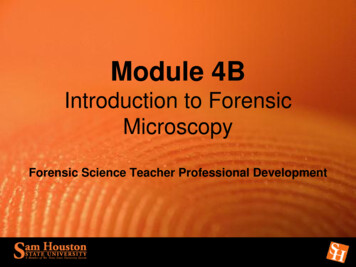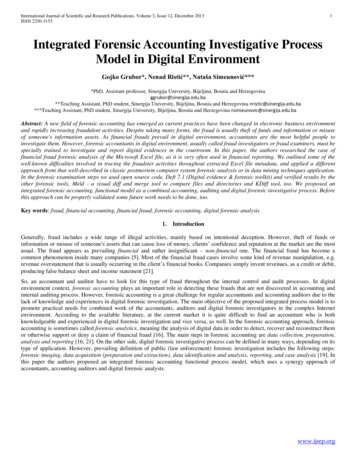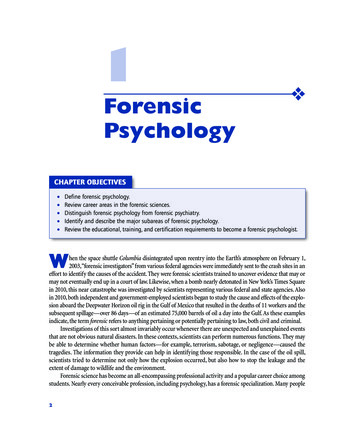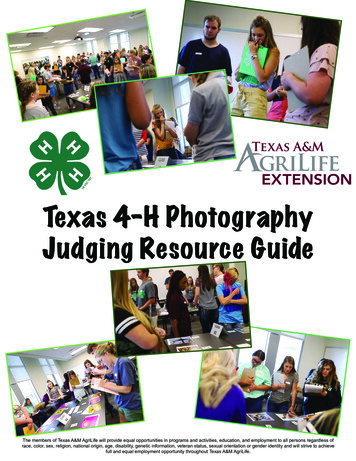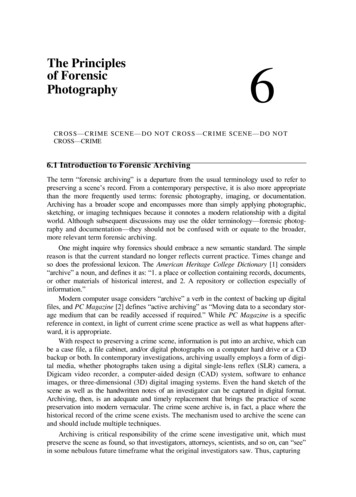
Transcription
The Principlesof ForensicPhotography6CROS S—C RI ME SCEN E —DO NOT CROSS —C RIME SCENE —DO NO TCROSS—CRIME6.1 Introduction to Forensic ArchivingThe term ―forensic archiving‖ is a departure from the usual terminology used to refer topreserving a scene’s record. From a contemporary perspective, it is also more appropriatethan the more frequently used terms: forensic photography, imaging, or documentation.Archiving has a broader scope and encompasses more than simply applying photographic,sketching, or imaging techniques because it connotes a modern relationship with a digitalworld. Although subsequent discussions may use the older terminology—forensic photography and documentation—they should not be confused with or equate to the broader,more relevant term forensic archiving.One might inquire why forensics should embrace a new semantic standard. The simplereason is that the current standard no longer reflects current practice. Times change andso does the professional lexicon. The American Heritage College Dictionary [1] considers―archive‖ a noun, and defines it as: ―1. a place or collection containing records, documents,or other materials of historical interest, and 2. A repository or collection especially ofinformation.‖Modern computer usage considers ―archive‖ a verb in the context of backing up digitalfiles, and PC Magazine [2] defines ―active archiving‖ as ―Moving data to a secondary storage medium that can be readily accessed if required.‖ While PC Magazine is a specificreference in context, in light of current crime scene practice as well as what happens afterward, it is appropriate.With respect to preserving a crime scene, information is put into an archive, which canbe a case file, a file cabinet, and/or digital photographs on a computer hard drive or a CDbackup or both. In contemporary investigations, archiving usually employs a form of digital media, whether photographs taken using a digital single-lens reflex (SLR) camera, aDigicam video recorder, a computer-aided design (CAD) system, software to enhanceimages, or three-dimensional (3D) digital imaging systems. Even the hand sketch of thescene as well as the handwritten notes of an investigator can be captured in digital format.Archiving, then, is an adequate and timely replacement that brings the practice of scenepreservation into modern vernacular. The crime scene archive is, in fact, a place where thehistorical record of the crime scene exists. The mechanism used to archive the scene canand should include multiple techniques.Archiving is critical responsibility of the crime scene investigative unit, which mustpreserve the scene as found, so that investigators, attorneys, scientists, and so on, can ―see‖in some nebulous future timeframe what the original investigators saw. Thus, capturing
110Crime Scene Forensicsthe essence of the scene is critical because it is impossible to predict a priori when anotherpair of eyes will need to review the ―original.‖ Importantly, too, no single archiving methodis sufficient, and the approaches vary from the simple process of taking notes and writingreports to using increasingly complex technology. An agency using only 35 mm or digitalcameras coupled with sketching and measuring is not doing its job properly. Similarly,videography alone is insufficient and inadequate as are the newer 3D archiving systems,though they are certainly capable of providing more accurate measurements. Eacharchiving method has attributes and deficiencies such that a complete and competentarchive of the scene requires a battery of techniques.The bottom line is that pictures are not enough. The reason requires a brief discussionof passive and active archiving and why the active process is the most appropriate approachfor archiving a scene.6.1.1 Passive ArchivingMany authors of crime scene investigation texts use the term ―scene processing‖ to describewhat happens during the scene investigation. When the crime scene unit enters a scene forthe first time and starts getting a ―feel‖ for what happened, a myriad of thoughts echothrough each investigator’s mind. Questions like those raised in Chapter 1 are relevant.However, once the team begins the archiving process, the actual steps involved may seemrote and removed. This is the connotation of what the term ―scene processing‖ seems toimply, a passive process of taking pictures. All scene investigators know they must photograph and sketch the scene, which includes measuring critical items of evidence in order tofix their location. Experienced scene investigators realize that photography, sketching, andvideography are techniques that complement each other and should not stand alone as theonly visual representation of the scene.The investigator who goes into the scene and begins taking photographs without thinkingabout what the scene is saying with respect to how the macroscene elements fit together is nottruly an active part of the investigation and, truthfully, is hardly engaged mentally. He is simply taking pictures or sketching. This is a passive activity. But is that all there is? Emphatically,No! Then, what else, is there? The answer is to engage the brain and make it an active partnerin the process, which, with respect to this discussion, is termed active archiving.6.1.2 Active ArchivingActive archiving is the process of combining the ―rote,‖ the passive aspect of archiving,with an engaged brain. Taking establishing photographs (i.e., overviews) of a room with adead body, while simply moving from one perspective to another, is passive archiving.What is wrong with this? Nothing, if the investigator is a robot.For example, the forensic photographer should think about the scene elements beingcaptured. Is it enough to record the body lying on the floor in a pool of blood or is it alsoimportant to ensure that the photograph also includes, say, the tip of the knife sticking outfrom under the forearm of the deceased? Is the depth of field (DOF) sufficient to capturethat information and the knife sticking out from under the sofa 6 ft behind the body of thedeceased? Missing the knife from either perspective might be a critical part of the eventualscene reconstruction because subsequent photographs might miss that angle. The singleline of blood droplets on the wall behind where the body lies might have come from blood
The Principles of Forensic Photography111castoff from a knife. This blood pattern must be captured in the same perspective as thebody and the knives, because it is important to understand the relationship of all items ofpotentially probative evidence. This means thinking carefully about each and everyphotograph.In every sense, the forensic photographic process is the visible investigation of thescene, and it is an essential part of an active investigation, where recreational and forensicphotography part ways. The artist wants to be creative and capture the scene from an artistic sense. The forensic photographer should not care about being artistically creative butabout being creative in the forensic sense. Each photograph must capture the best perspectives at the scene in order to capture its story. Like the artistic photographer who allows thelandscape to guide the artistic process, the forensic counterpart permits the scene to guidethe continuum of photographs from relevant evidence to relevant evidence. Indeed, thismight seem paradoxical because the forensic photographer must capture everything.The following list reviews the differences between passive and active archiving. Themost important is that the photographer/sketcher uses the scientific method to ensure success during the process. Passive Unthinking documentation of a crime scene using photography, sketching,and other archival media. No distinct evidence recognition process occurs before or at this point. The scene is archived as found. Active Rigorous use of the scientific method yields greater thoroughness, objectivity,and evidence recognition. A process to record physical evidence but which transcends rote archiving. Uses the criminalist’s holisitic approach. Recognize physical evidence. Answers relevant investigative questions. Guarantees the most complete archive. Minimizes bias in the investigation.6.2 Techniques of Forensic ArchivingArchiving is classified into technology types: SLR digital photography, digital/high-definition videography, manual sketching, CAD systems that render scenes in 3D, and 3D imaging systems that use infrared (IR) lasers to make the measurements. An emerging methodthat has not yet gained widespread application to crime scene work utilizes 3D printingtechnology. Here, the data from a 3D imaging system is sent to a ceramic printer thatprints a 3D ceramic mold of the original scene.6.2.1 Digital Forensic Photography (Photographic Archiving)It might seem like a mistake to consider only digital applications because it does not consider the vast history of photography in a forensic context. Modern scene investigators,though, mostly use digital photography. For this reason, it is important that students and
112Crime Scene Forensicsnovice investigators understand the basic functions of the digital camera and how it is usedto photograph scenes of crimes. Certainly, any forensic student should be aware of thisinteresting history, but digital applications are considered because they are more relevantfor students; digital is the present and the future.Photography is an essential skill, and all scene scientists/investigators must be familiarwith its principles as they relate to forensic archiving. Several texts have been written on thesubject [3–7], and students should be aware of specialized texts on the subject as well as published material on specialized aspects, for example, ultraviolet (UV) and IR applications.After reading several of these texts, one might come away with the impression thatforensic photography is magical or a mystical manifestation of the medium. However, thisis not true. It is photography pure and simple, and, like any worthwhile endeavor, expertisetakes time and practice. The purpose of this chapter is to acquaint the forensic student andnovice investigator with the basics of photography and forensic applications so that theycan learn to archive mock scenes competently. One caveat, though. This discussion will notconsider digital evidence comparisons, software enhancements of images, or image processing except, perhaps, as simple examples.6.2.2 The Purpose of Forensic PhotographyWhen asked what the purpose of forensic photography is, students generally respond witha puzzled expression, maybe a shrug. Maybe the question is too simple or naive. Often, thereply is, ―To document the scene.‖ The true response is not quite that simple. Forensic photography has much more far-reaching implications. The most obvious are straightforwardand listed below: Record and preserve the as-found condition of the sceneShow the relative position of evidence at the sceneEstablish the relative dimensions of evidenceCross-complement other archiving techniquesPreserve the as-found scene for future referenceCertainly the above are important reasons, but there are others. Consider the hypothetical case where the defendant is convicted of a murder and sentenced to life imprisonment or even the death penalty. If, on appeal, the defense finds potentially exculpatoryevidence and if a judge rules that the convicted defendant should be granted a new trial, theinvestigation begins anew. The first investigators—defense and prosecution—will be looking for anything supporting the original conviction or an acquittal. This information mightbe the original scene photographs. One might say, ―Well, those photographs were standardoperation procedures for documenting the scene.‖ Maybe, but those photographs shouldbring the scene back to life and thus play an integral part in the second investigation.But what if the photographs were not good? Maybe at trial, the only photographs of thebody shown to the jury had been taken by the medical examiner during the autopsy. Thismeans the jury did not see the position of the deceased at the scene relative to the evidencethere. In light of the judge’s ruling, scene scientists/investigators will be scrambling to examine all of the original scene photographs in order to find something that had not been considered carefully during the first investigation. Maybe that something turns out to be abloodstain pattern that had been ignored during the original investigation. Since that blood-
The Principles of Forensic Photography113stain pattern is no longer available, the photograph is the only record available, and if thephotograph did not have the proper forensic perspective it might be worthless as an investigatory tool or as evidence. If captured properly, it could play a pivotal role in a retrial.The importance of scene photography/archiving relates to the overriding responsibilityof the investigator to capture the details of the scene without missing anything and theintegral relationships of evidence. The paradox is that forensic photography, per se, is aninsufficient medium to capture everything. Regardless, this is the challenge.6.2.3 Critical Aspects of Forensic PhotographySince this discussion focuses solely on digital photography, discussing categories of digitalcameras might seem important, but only two digital camera types should be used in forensic work: the SLR digital camera with interchangeable zoom lenses. One other example ofa digital camera, which really is not a different category of camera, is one that has beenmodified for IR and/or UV photography. Most of the commercially available digital cameras can be modified for IR photography.The first step for the student and the novice investigator is to become familiar with thecamera’s functions. Experience shows that even students who have had a course in photography are not prepared to photograph crime scenes. For appropriate forensic photography,the following photographic equipment is required: An SLR digital camera having, minimally, the capability to take burst photos,adjustable white balance (WB) choices, and a menu for manipulating the WB,International Standards Organization (ISO) selections ranging from 100 to 6400,manual override modes (aperture, shutter, and manual, and program priorities),and exposure compensation. It should also have an external flash attachment. Close-up (macro) lens—f/1.4 or f/2.8, 60 mm. Zoom lenses: f/2.8, 18–70 and 70–200 mm, or f/3.5, 18–200 mm. Polarizing lenses to eliminate glare. Ball-head tripod. External flash. Lighting slaves. Light towers. Appropriate filters for use with an ALS: yellow, orange, and red. Ring flash attachment. Scales.6.3 The SLR Digital CameraSeveral SLR cameras are available in the marketplace, most of which are upgraded periodically or discontinued as new models arrive. Once a camera is chosen, there is no need tocontinually upgrade. But, why are SLR digital cameras appropriate for forensic photography?In a word, they are versatile, and their specific attributes are listed below: Changeable lenses are to meet specific photographic challenges The investigator sees exactly what the lens ―sees‖ unless the camera is modified forIR photography.
114Crime Scene Forensics Higher-quality digital SLRs have large image sensors and produce higher-qualityphotos. Near-zero lag time.Operating digital SLR cameras is not complicated, although students sometimes struggle to learn its functions. The basic camera operation is rather simple, as explained below,although its advanced functions are typically software-controlled. The basic operationalaspects of the digital SLR camera are easily found on the Internet [3,4]. In most professionstechnology and techniques have a specialized lexicon, and digital cameras and photography are no exception, so it is important to understand and use the terminology. See Table6.1 for a list of terms commonly used in digital applications.Table 6.1 Common Terms Used in Digital ApplicationsTermMegapixelsISO (and image noise)Dust controlImage stabilizationLive viewDynamic rangeCrop factor [4]Auto-focus systemsContinuous driveFile formats.Digital sensorExplanationMore megapixels give you the ability to make larger prints and to crop yourphotos. They do not necessarily have higher image quality.Increasing the ISO, say from 200 to 800, lets you take clear photographs in dimlight without a flash, but at the expense of image degradation.Dust on an SLR sensor appears as small black spots in photographs. Dustcontrol systems attempt to prevent and eliminate this.Two types of stabilization: one that is included inside the camera and one thatis inside the lens.Composing photographs using the LCD screen on the back and the viewfinder.SLR cameras do not match the human eye with regard to seeing details in ascene, even when there is extreme contrast.A digital SLR sensor is smaller than a frame of 35 mm film, so only a portionof the image that passes through the lens is captured digitally. The effect is anartificial zoom of the image. The eye captures everything. Crop factors aremanufacturer-specific, but generally a wide-angle lens on a Nikon digitalcamera (e.g., 28 mm) will be similar to having a 42-mm lens camera(28 1.5) (see Figure 6.1).Auto-focus systems can include anywhere from three to more focus points.Number of focus points reflects the accuracy of the SLR digital system.A continuous drive allows multiple photographs in rapid succession.Forensic photography should be shot in dual format—RAW and JPG. When adigital camera captures images in the RAW format, it does not process thedata; the images remain unedited. When a camera captures image data in theJPG format, the camera processes the files such that information is lost: colorsaturation, sharpness, and contrast. Processing cannot be undone [5].Light hits a digital sensor that varies in type and expense. The two mostcommon sensors are the CCD and the CMOS. The CCD is the most commonand is typically found in lower-end SLR cameras. Most higher-end SLR digitalcameras use the CMOS sensor. Benefits of the latter are lower powerconsumption, less expensive to produce, and, since each pixel has a linkedamplifier, it can transfer data easier. Other digital sensors include the superCCD found on Fuji Film’s cameras and the Foveon found in the Sigma rangeof digital SLRs [5].
The Principles of Forensic Photography115Students marking pitch on powder dusted exemplar treadInside yellow circle is what the human eye seesInside the orange box is what the 35 mm camera showsInside the white box is what the digital cameral showsFigure 6.1 Crop factor photograph.Workshop I on forensic photography introduces students to the digital camera.Expectedly there is a progression or learning curve. At the end of the first afternoon, thestudents are unsure of their photographic abilities because they have not yet established arelationship with the camera. Unknown to them, they have started taking baby steps towardarchiving mock crime scenes. In the ensuing weeks they learn about several scene-relatedtopics (e.g., fingerprinting, etc.), and some forget some of the camera basics. Instructors reinstruct them as they work through the mock scenes, and, by the end of the course, they are asproficient as many professionals forensic archivers. The students encounter several purposefully set photographic challenges and explore the forensic aspects of IR photography that canhave important applications in forensic investigations. By the end of the course, the studentshave taken giant steps in proficiency, but they still need practice before becoming experts.6.4 Essential Skills of Forensic Photography6.4.1 Focus: “If it’s not in Focus, the Rest doesn’t Matter”Gone are the days when the photographer has to wait for the film to be developed beforelearning whether a photograph is in sharp (tack sharp) [6] focus because the liquid crystaldisplay (LCD) viewer on digital cameras allows for immediate inspection of the results.However, the LCD viewer on the digital camera can fool you. Its images are small, andphotographs may appear in focus on the LCD but out of focus on the computer screen.Thus, the LCD is a useful guide but not the final arbiter of whether a photograph is in focus.Having photographs in sharp focus, called ―tack sharp,‖ is vitally important to professionaland forensic photographers. Blurry photographs have little use to either, and serve no legitimate investigative purpose in forensic archiving. The following guidelines listed aredesigned to help ensure that photographs are in sharp, ―tack sharp,‖ focus. Use a tripod with a ball-head mount or at least a monopod. Hand-held photography is for amateurs, and forensic archivers are not supposed to be amateur photographers. There are times during investigative situations where a hand-heldprocedure is the only way to get the correct photograph. In these situations, thephotographer must be extra careful.
116Crime Scene Forensics Pressing the shutter while taking the photograph moves the camera. The solutionis not to press the shutter. Instead, use a cable release, the self-timer function onthe camera, or the IR wireless remote shutter. Lock the camera’s mirror in the ―up‖ position. Normally, the camera moves themirror up and locks it while taking the photograph. This causes movement insidethe camera. The solution is to move the mirror up manually using the camera’s―exposure delay mode‖ (Nikon) or ―mirror lockup‖ (Canon) before taking the photograph. According to Kelby [6], this is the second most important precaution nextto the use of a tripod to keep photographs tack sharp. Vibration reduction (VR) (Nikon) or image stabilization (IS) (Canon) is designedto minimize vibration that comes from pressing the shutter on the camera. Thisfunction is resident in either the lens or the camera. Regardless, it works by looking for a vibration and tries to minimize it. If the camera is on a tripod, wherethere is no vibration, the VR system searches for it, during which it causes a slightvibration. The rules of thumb: If the camera is hand-held, activate the VR system. If the camera is on a tripod, inactivate the VR system. Shoot at the sharpest aperture of the lens. Generally, this is about two full stopssmaller than wide open. So, if the lens being used is f/2.8, the sharpest aperturesfor that lens would be f/5.6 and f/8 (two full stops down from 2.8). Not always absolute, this is a general rule; a place to start. Each lens has a sweet spot from which itdelivers its sharpest images. The photographer ascertains the characteristics of thelenses used at scenes. High-quality lenses make a difference. Use high-quality ―glass‖ for tack sharpphotographs. Avoid high ISOs if possible. When shooting on a tripod in dim light, do not increasethe ISO. Keep the ISO at the lowest possible setting. The resulting photographswill be sharper. If the camera is handheld in dim light, it may be impossible to getthe photograph without using a higher ISO. Because the LCD on the camera back is an unreliable gauge of focus, use the zoomfeature on the camera to examine the photograph detail for focus. Out-of-camera image manipulation (e.g., Photoshop) can help with focus. Softwaremanipulation of images for forensic purposes is not necessarily bad, but the original image must remain with modification. In fact, there is a trend to avoid or noteven allow software manipulation of photos. If this continues, the burden is on thephotographer to capture forensically perfect photographs every time. Hand-holding the camera in anything but direct sunlight increases the likelihood of obtaining out-of-focus photographs. A trick is to use the camera’s burstfunction. The chances are good that one of the resulting photographs will be infocus. In hand-holding situations, bracing the camera against something (e.g., a wall, arailing, etc.) can steady it sufficiently to obtain sharp photographs.6.4.2 The Correct Forensic ExposureExposure refers to the amount of light entering the camera and has been defined as, ―Theduration and amount of light needed to create an image‖ (pp. 32–33, [7]) or ―The subjection
The Principles of Forensic Photography117of sensitized film to the action of light for a specific period‖ (p. 266, [8]). The first definitionmakes more practical sense. The basic unit of exposure is the ―stop,‖ where one stop is theequivalent of doubling or halving the amount of light entering the camera, which the photographer controls by adjusting the aperture, shutter speed settings on the camera or theISO. The ISO setting plays a role in how the digital sensor handles light.The difference between a shutter speed of 1 and 2 s is one stop and between 1 and 4 s,two stops. Controlling exposure allows the photographer to obtain that perfect forensicperspective, the one that tells the best forensic story. Only then does the photograph havethe correct forensic exposure. Said in another way, the correct forensic exposure allows theperfect amount of light into the camera so that the scene can tell its ―story.‖ A challenge isthat different camera settings can allow the same amount of light to enter the camera.These are known as equivalent exposures. For example, the following camera settings allowthe same amount of light to hit the digital sensor.6.4.2.1 Equivalent ExposuresThe following camera settings allow the same amount of light into the camera, so they areconsidered equivalent exposures. f/8—f/stop and 1/4 second shutter speed f/ 11—f/stop and 1/2 second shutter speed f/16—f/stop and 1 second shutter speedPhotographs taken at each of the above exposures vary subtly. From a forensic perspective, the photographer chooses the best exposure(s). Interestingly, the photograph tellingthe best forensic story may not be the one chosen by a casual viewer. The reason is that acasual viewer does not consider forensic detail but instead how the overall photographappeals esthetically. The sets of photographs in Figure 6.2, of a bloodstain spatter at a mockscene, were purposely shot using identical exposures using an 18–55-mm zoom lens without a flash.In Figure 6.2, photograph no. 1—blood spatter on a tile floor, the camera (Nikon D50)was set on aperture priority and an appropriate f/stop chosen; the camera selected the shutter speed. For photograph nos 2–4, the camera was set to manual priority and then adjustedso that each f/stop and shutter combination resulted in the same amount of light enteringthe camera as for photograph no. 1. A quick glance shows that the photographs are similarbut not identical. The most obvious difference is the color of the tile floor and the overalldarkness of the photograph. From a forensic perspective, photograph no. 2 has the bestforensic exposure. First, the color of the floor is the closest to the actual color. Second, thedetail in the photograph is the best, and, third, the overall complexion (darkness) of thephotograph, although photograph no. 3 appears slightly lighter, is more appropriate forforensic purposes.So, what makes this photograph more forensically relevant? None of the photographswere shot at the lens extremes; however, the f/11 photograph is better because the shot iscloser to the middle of the range of the lens, about two stops down from the maximum ofthe lens. The lens is an 18–55-mm zoom with two maximal apertures: f/3.5 and f/5.6. Thisis a kit lens that compromises the ability of the lens to work in minimal light at low f/numbers. Thus, the f/3.5 maximal aperture at the low end of the range is not optimum forforensic work (see above discussion on focus in Section 6.4.1).
118Crime Scene Forensics#1 -f /8 @ 1/15th sec#2 -f /11 @ 1/8th sec#3-f /16 @ 1/4th sec#4-f/22 @ 1/2 secFigure 6.2 Photographs of bloodstain spatter using equivalent exposures. (Photograph byRobert C. Shaler.)Keep in mind that the photographs in Figure 6.2 were not taken with a flash and theywere purposely shot using equivalent exposures. A darker exposure, though not the darkest, was chosen as the best for forensic work. The reason is that slightly darker photographsare often better forensic choices because software enhancements can lighten the photograph without losing detail, but darkening them is usually not as successful. Additionally,overexposed photographs often loose detail, which is critical for properly archiving thecrime scene. Kelby believes the opposite, reasoning that overexposure produces less noise,which is usually present in shadows. He believes that lightening the photograph using software increases noise in the resulting photograph [9]. For artistic purposes this is probablytrue, but forensic archiving is all about detail and overexposed photographs can lose important forensic information that is not always easily recovered. The following discussion centers on the camera functions that students must master in order to control exposure.6.4.3 ApertureAperture refers to the size of the hole through which light enters the camera. This openingto the camera’s external world is covered by a mechanical shutter that closes more quicklyor more slowly (shutter speed), which limits the time the digital sensor is exposed to thelight. The camera settings used to adjust the size of the hole are called f/stops or f/numbers.For most students, the two terms are confusing and counterintuitive because the larger thef/number, say f/11 or f/22, the smaller the hole and vice versa. Aperture settings are theforensic equivalent of gold. It is the first camera setting that the photographer considerswhen photographing anything at the crime scene because it controls the most importantperspective: What is in focus. This is another way of referring to DOF (see Section 6.8.3.4below).
The Principles of Forensic Photography119The relationship between aperture opening and f/number is ill
6.2.1 Digital Forensic Photography (Photographic Archiving) It might seem like a mistake to consider only digital applications because it does not con-sider the vast history of photography in a forensic context. Modern scene investigators, though, mostly use digital photography





